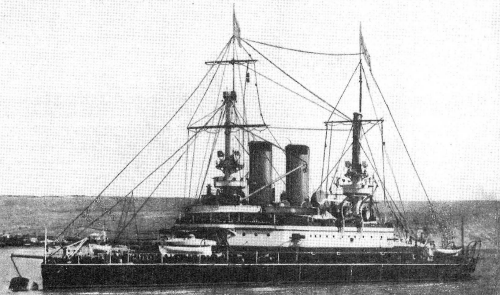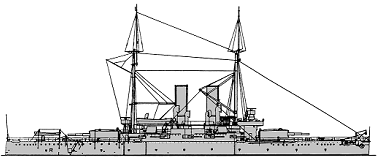
NAVYPEDIA
 Support the project with paypal
Support the project with paypal
Photo

Tri Sviatitelia
Ships
| Name | No | Yard No | Builder | Laid down | Launched | Comp | Fate |
|---|---|---|---|---|---|---|---|
| Три Святителя [Tri Sviatitelia] | Nikolayev Admiralty | 16.9.1891 | 12.11.1893 | 8/1897 | captured by Germany 1.5.1918 |
Technical data
| Displacement normal, t | 13318 |
|---|---|
| Displacement full, t |
|
| Length, m | 115.1 |
| Breadth, m | 22.3 |
| Draught, m | 8.66 max |
| No of shafts | 2 |
| Machinery | 2 VTE, 14 cylindrical boilers |
| Power, h. p. | 11300 |
| Max speed, kts | 16.5 |
| Fuel, t | coal 850 |
| Endurance, nm(kts) | 2430(10) |
| Armour, mm | Harvey and nickel steel; belt: 457 - 229, turrets: 406, battery: 127, deck: 76 - 51, CT: 305 |
| Armament | 2 x 2 - 305/38, 14 x 1 - 152/44 Canet, 4 x 1 - 120/43 Canet, 2 x 1 - 64/17 Baranovski, 10 x 1 - 47/40 Hotchkiss, 10 x 1 - 37/20 Hotchkiss, 6 - 381 TT (1 bow, 4 beam, 1 stern) |
| Complement | 753 |
Standard scale images

Tri Svyatitelya 1914
Graphics
Project history
Black Sea Fleet. In general conception very similar to the Nile and Trafalgar, the turrets not having individual armoured bases. The 152mm guns were in a cramped upper deck battery, and the 120mm with 6 of the 47mm in an unarmoured battery above.
Ship protection
The lower strake of the belt ran for 75m and from 0.5m above to 2.0m below lwl. It was 457mm max reduced to 229mm at the lower edge and to 406mm fore and aft, ending in 406-356mm bulkheads. The upper strake ran for 66m and was 2.4m wide and 406mm thick, ending in curved 406mm bulkheads. The 76-51mm armour deck was only present outside the area covered by the belt upper strake.
Modernizations
1912: - 6 x 1 - 152/44, 4 x 1 - 120/43, 8 x 1 - 47/40, 10 x 1 - 37/20, 6 - 381 TT
1915: + 2 x 1 - 57/43 Nordenfelt AA
Naval service
In spite of her obsolete design she was a useful member of the Black Sea Fleet in the First World War and took part in several operations with the other pre-dreadnoughts. Tri Sviatitelia was laid up at Sevastopol in March 1918 and captured 1.5.1918 by German troops. 24.11.1918 she was captured by British-French troops and demolished by them 22-24.4.1919. 29.4.1919 she was captured by Reds, 24.6.1919 by Whites and finally liberated by Red Army 15.11.1920. She was never re-commissioned and sold for BU in 1923.
 HOME
HOME FIGHTING SHIPS OF THE WORLD
FIGHTING SHIPS OF THE WORLD RUSSIA / USSR
RUSSIA / USSR CAPITAL SHIPS AND MONITORS
CAPITAL SHIPS AND MONITORS TRI SVIATITELIA turret ship (1897)
TRI SVIATITELIA turret ship (1897)
